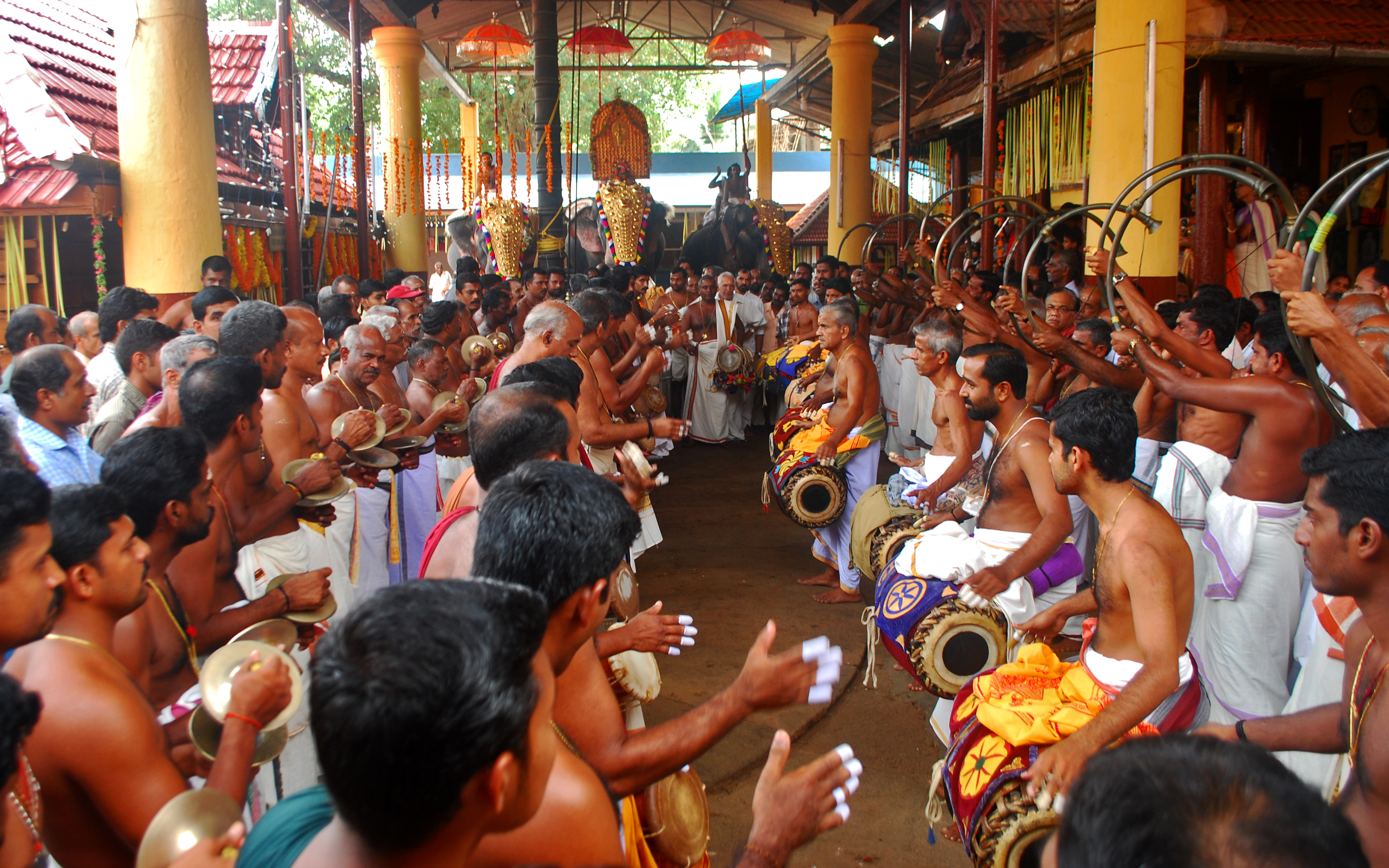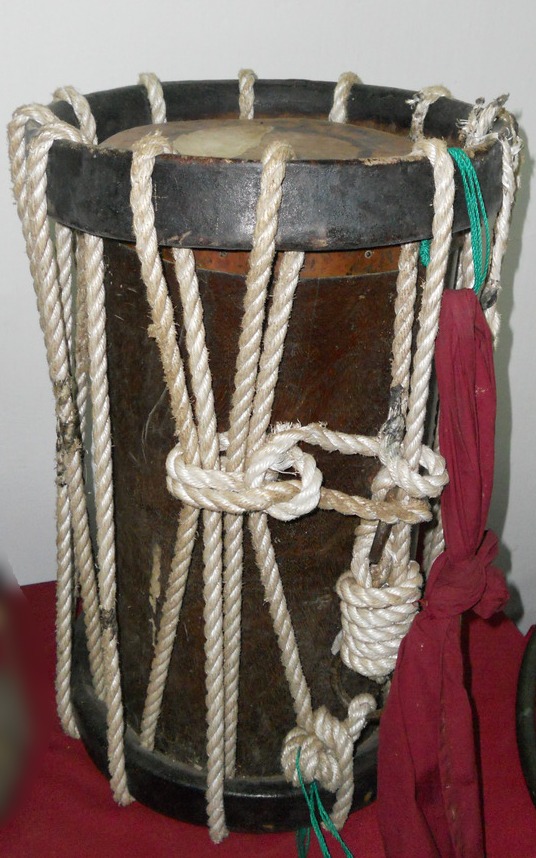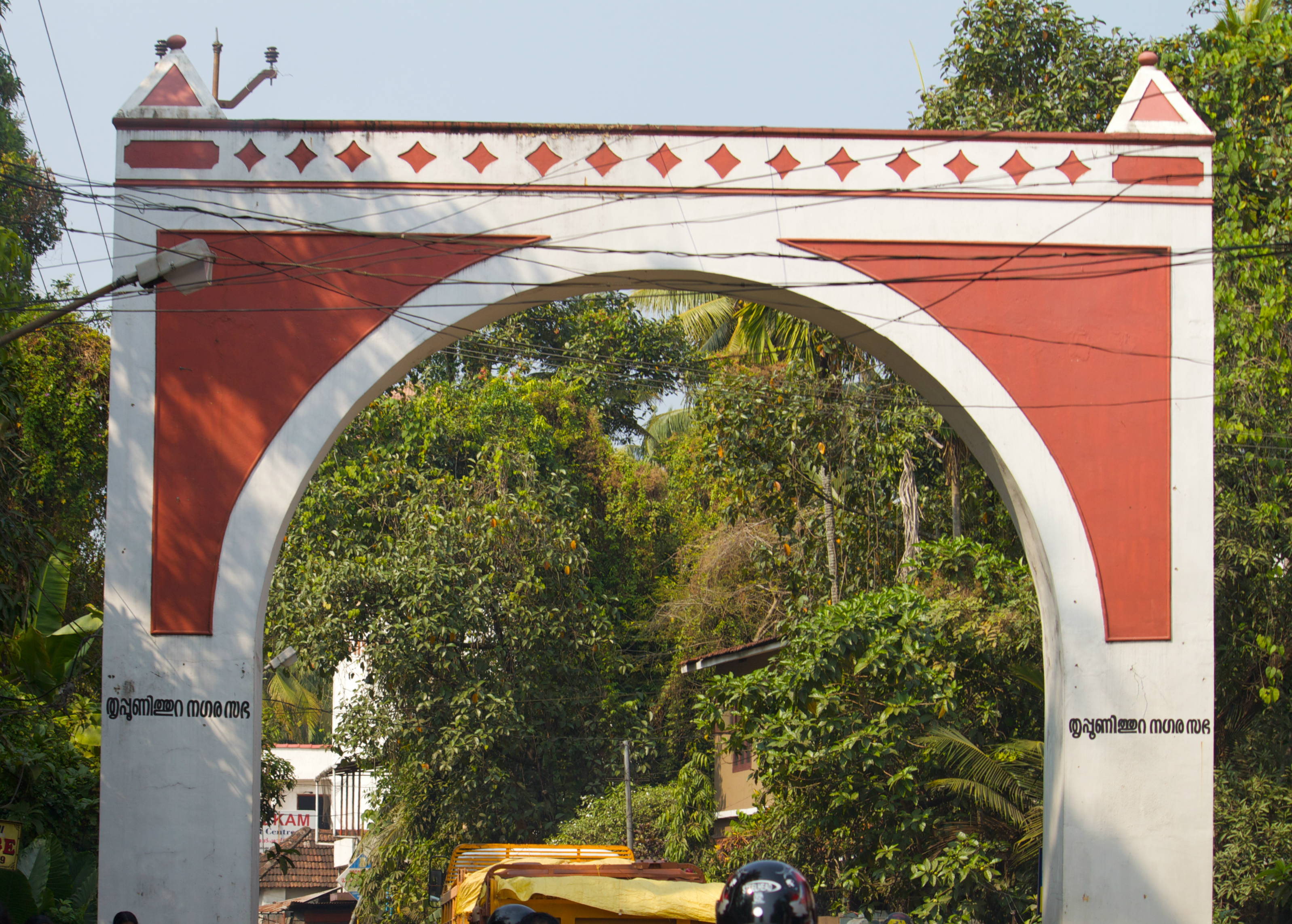|
Thayambaka
Thayambaka or tayambaka is a type of solo chenda performance that developed in the south Indian state of Kerala, in which the main player at the centre improvises rhythmically on the beats of half-a-dozen or a few more chenda and ilathalam players around. Performance A thayambaka performance on the chenda has thus its focus on the stick-and-palm rolls produced on the itantala (treble) of the chenda, while the rhythm is laid by his fellow instrumentalists on the (bass) and ( cymbals).Simon Broughton, Mark Ellingham. ''World Music'', vol. 2, p. 97 (contributor Rolf Killius). Rough Guides, 2000. Thayambaka, believed to have flourished during the feudal era, spans an average of 90 minutes. It begins at a slow pace before scaling on to a medium tempo and eventually culminating in high, frenzied speed. It has a skeletal pattern on which the performance progresses, but the main performer has the liberty to improvise and innovate to showcase his grip of rhythm, finesse of techniqu ... [...More Info...] [...Related Items...] OR: [Wikipedia] [Google] [Baidu] |
Mattannur Sankarankutty Marar
Mattanur Sankarankutty (M. P. Sankara Marar) is an Indian percussionist who plays the chenda (a traditional Kerala drum), Thayambaka, Panchari melam, and Panchavadyam. He was born in Mattanur in Kannur district of Kerala. He was awarded the Padma Shri by the Government of India in 2009 and the Sangeet Natak Akademi Award in 2012. Mattanur, as he is known, is married to Bharathi, a native of Tirur in Malappuram district. They have two sons, Mattannur Sreekanth and Mattannur Sreeraj. Both Sreekanth and Sreeraj are also popular Thayambaka artists. See also *Pallavur Appu Marar *Peruvanam Kuttan Marar Peruvanam Kuttan Marar is a chenda artist. He leads several popular traditional orchestra performances in Kerala. He received Padma Shri, India's third highest civilian award, in 2011 for his contributions in the field of art. Early life Peruv ... * Kelath Aravindakshan Marar References Living people Indian percussionists Malayali people People from Kannur ... [...More Info...] [...Related Items...] OR: [Wikipedia] [Google] [Baidu] |
Pallavur Appu Marar
Pallavur Appu Marar (1928-2002) was an Indian percussionist, widely considered to be a maestro in the Pallavur (Palakkad) style of thayambaka, edakka, sopana sangeetham, melam and panchavadyam. He was the eldest of the three brothers, the other two being Pallavur Manian Marar and Pallavur Kunhikuttan Marar, who formed the famed Pallavur trio. Biography Appu Marar was born in 1928, at Pallavur, a small hamlet in Palakkad district, in the south Indian state of Kerala, to Shankaran Marar and Ammini. His father, a nomad, left the young Appu and his mother, when he was one year old, throwing the family into poverty. Ammini was forced to remarry Subramania Iyer, and had two more sons, Manian and Kunhikuttan, who, years later, completed the ''Pallavur trio''. Appu started learning traditional percussion instruments at a very young age and had his ''arangettam'' (debut) on chenda, at Pallavur Shiva Temple, the age of 8. He, soon, became adept at playing chenda, edeka and timila, u ... [...More Info...] [...Related Items...] OR: [Wikipedia] [Google] [Baidu] |
Chenda
The Chenda ( ml, ചെണ്ട, ) is a cylindrical percussion instrument originating in the state of Kerala and widely used in Tulu Nadu of Karnataka and Tamil Nadu in India. In Tulu Nadu (Coastal Karnataka), it is known as ''chende''. It is greatly identified as a cultural element in Kerala and Tulu Nadu. This instrument is famous for its loud and rigid sound. A Chenda has two sides, the left side called "Edamthala" (ഇടം തല)(Left Head) and the right side "Valamthala" (വലം തല)(Right Head). The "Edamthala" is made of only one/two layer of cow skin and the "Valamthala" will have a five/seven layer skin, so as to have a bass sound. The skin are dried in the shade and fastened on wooden rings (Chenda Vattam, ചെണ്ട വട്ടം) made of the trunk of a locally available palm tree (Eeranpana) or bamboo, using a gum prepared from the seed of a tree called "pananchi maram". The circular frame is kept in a vessel, boiled for an entire day and then ... [...More Info...] [...Related Items...] OR: [Wikipedia] [Google] [Baidu] |
Ilathalam
Elathalam, or Ilathalam, is a metallic musical instrument which resembles a miniature pair of cymbals. This instrument from Kerala in southern India is completely made out of bronze and has two pieces in it. Elathalam is played by keeping one part of the cymbal in left hand banging the other cymbal to the one in left hand. Even though this instrument is small by size, it does have more thickness than the common cymbal, and thus gives a distinct chime. Elathalam is never a lead instrument but is used in a number of ethnic Kerala percussion ensembles like Panchavadyam, Chenda melam, Thayambaka and Kailaya vathiyam besides by second singer on a Kathakali stage beside providing the beat in Kuzhal Pattu and Kombu Pattu. Masters of Elathalam Leading elathalam masters of the present day include:Cheriyath Thanku Marar, Chelakkara Unnikrishnan, Maniyamparambil Mani, Kothachira Sekharan Nair, Chengamanad Paramu Nair, Pallavur Raghava Pisharody, Chelakkara Jayan, Pookottur Sasidharan (Asi ... [...More Info...] [...Related Items...] OR: [Wikipedia] [Google] [Baidu] |
Panchavadyam
Panchavadyam (Malayalam: പഞ്ചവാദ്യം), literally meaning an orchestra of five instruments, is basically a temple art form that has evolved in Kerala. Of the five instruments, four — timila, maddalam, ilathalam and idakka — belong to the percussion category, while the fifth, kombu, is a wind instrument. Much like any chenda melam, panchavadyam is characterised by a pyramid-like rhythmic structure with a constantly increasing tempo coupled with a proportional decrease in the number of beats in cycles. However, in contrast to a chenda melam, panchavadyam uses different instruments (though ilathalam and kompu are common to both), is not related very closely to any temple ritual and, most importantly, permits much personal improvisation while filling up the rhythmic beats on the timila, maddalam and idakka. Panchavadyam bases itself on the seven-beat thripuda (also spelt thripuda) thaalam ( taal) but amusingly sticks to the pattern of the eight-beat chempata ... [...More Info...] [...Related Items...] OR: [Wikipedia] [Google] [Baidu] |
Sadanam Divakara Marar
Sadanam Divakara Marar was an Indian percussionist, known for his scholarship on sopana sangeetham, ''marappani'', ''parisha vadhyam'' and ''thimila paani'' and his mastery over various temple and ritual percussion instruments of traditional Kerala music. Biography Divakara Marar was born on 29 April 1937, to Venkittaramanan Embranthiri and Parukutti Marasyar Amma at Pazhoor, a small hamlet near the town of Piravom, Ernakulam district, in the south Indian state of Kerala. Marar started learning music at the age of nine, under the tutelage of his uncles, Narayana Marar and Kunjikrishna Marar. Later, aged 18, he enrolled at Unnayi Warrier Smaraka Kalanilayam, Irinjalakuda, a known Kathakali institution and mastered chenda, under the guidance of Alankarathu Appu Marar. He, then, submitted himself to advanced training on chenda under the renowned chenda exponent, Chandra Mannadiar. This was followed by his training stint on thayambaka at '' Peroor Gandhi Seva Sadanam'', which add ... [...More Info...] [...Related Items...] OR: [Wikipedia] [Google] [Baidu] |
Kalpathy Balakrishnan
Kalpathy Balakrishnan is an Indian percussionist who plays the chenda (a traditional Kerala drum), Thayambaka, Panchari melam, and Panchavadyam. He was born in the famous village called Kalpathy in the Palakkad district of Kerala Kerala ( ; ) is a state on the Malabar Coast of India. It was formed on 1 November 1956, following the passage of the States Reorganisation Act, by combining Malayalam-speaking regions of the erstwhile regions of Cochin, Malabar, South .... He won Kerala Sangeeta Nataka Akademi Award for the best thayambaka artist. References Indian percussionists Malayali people Chenda players Living people Year of birth missing (living people) {{drummer-stub ... [...More Info...] [...Related Items...] OR: [Wikipedia] [Google] [Baidu] |
Idakka
The ''idakka'' (), also spelt edaykka/edakka, is an hourglass-shaped drum from Kerala in south India. This handy percussion instrument is very similar to the pan-Indian damaru. While the damaru is played by rattling knotted cords against the resonators, the idakka is played with a stick. Like the damaru, the idakka's pitch may be bent by squeezing the lacing in the middle. The idakka is slung over the left shoulder and the right side of the instrument is gently beaten with a thin curve-ended stick. It is played in temples and in performances such as Kathakali and Mohiniattam classical dance. Etymology The Malayalam name idaykka or idakka is originated from the Sanskrit word श्रीढक्का (Śrīḍhakkā). In Sanskrit, a ḍhakkā is described as a double drum which makes ''ḍhak'' sound. ढक् इति गभीरशब्देन कायतीति (ḍhak iti gabhīraśabdēna kāyatīti). The sacred prefix Śrī is used to denote the auspiciousnes ... [...More Info...] [...Related Items...] OR: [Wikipedia] [Google] [Baidu] |
Travancore
The Kingdom of Travancore ( /ˈtrævənkɔːr/), also known as the Kingdom of Thiruvithamkoor, was an Indian kingdom from c. 1729 until 1949. It was ruled by the Travancore Royal Family from Padmanabhapuram, and later Thiruvananthapuram. At its zenith, the kingdom covered most of the south of modern-day Kerala ( Idukki, Kottayam, Alappuzha, Pathanamthitta, Kollam, and Thiruvananthapuram districts, and some portions of Ernakulam district), and the southernmost part of modern-day Tamil Nadu (Kanyakumari district and some parts of Tenkasi district) with the Thachudaya Kaimal's enclave of Irinjalakuda Koodalmanikyam temple in the neighbouring Kingdom of Cochin. However Tangasseri area of Kollam city and Anchuthengu near Attingal in Thiruvananthapuram district, were British colonies and were part of the Malabar District until 30 June 1927, and Tirunelveli district from 1 July 1927 onwards. Travancore merged with the erstwhile princely state of Cochin to form Travancore-Cochin i ... [...More Info...] [...Related Items...] OR: [Wikipedia] [Google] [Baidu] |
Tripunithura Nandini Varma
Thrippunithura or Tripunithura (), is a prominent historical and residential region in the City of Kochi in Kerala, India. Located about 7 km (4 mi) from the city centre, Tripunithura was the capital of the erstwhile Kingdom of Cochin. The descendants of the Cochin royal family still live in the palaces here. The Hill Palace situated in Tripunithura was the palace of Maharaja of Cochin, the ruler of Kingdom of Cochin. Tripunithura is also well known for its historical cultures and worldwide famous because of Sree Poornathrayeesa Temple and the annual festival ''Vrishchikoltsawam'' that takes place at the temple. In local administration, it is a municipality named Tripunithura Municipality. In the state administrative structure, Tripunithura is part of the Ernakulam District in the state of Kerala. Etymology Some latter day Sanskrit enthusiasts describe the origin of the name to "pūrṇa vēda puri" — the town of Vedas in its entirety. Another possible origi ... [...More Info...] [...Related Items...] OR: [Wikipedia] [Google] [Baidu] |
Thiruvegappura
Thiruvegappura (also spelled Thiruvegapura) is a village in Pattambi Taluk Palakkad district in the state of Kerala, India. It is administered by the Thiruvegapuram gram panchayat. Main roads passing through Thiruvegappura Panchayat are Ponnani - Palakkad road, Pattambi - Perinthalmanna Road, Pattambi - Valanchery road, and Pattambi - Kozhikode road.http://lsgkerala.in/thiruvegappurapanchayat/history/ Tirur - Shornur Railway line and Nilambur-Shoranur line passes through here. Nearest Municipal town is Valanchery in Malappuram district (about 6 km away). The villages lies on the bank of river Thutha, a tributary to the Bharathapuzha River. Demographics India census A census is the procedure of systematically acquiring, recording and calculating information about the members of a given population. This term is used mostly in connection with national population and housing censuses; other common censuses in ..., Thiruvegapura had a population of 29,810 with 14 ... [...More Info...] [...Related Items...] OR: [Wikipedia] [Google] [Baidu] |
Kozhikode
Kozhikode (), also known in English as Calicut, is a city along the Malabar Coast in the state of Kerala in India. It has a corporation limit population of 609,224 and a metropolitan population of more than 2 million, making it the second largest metropolitan area in Kerala and the 19th largest in India. Kozhikode is classified as a Tier 2 city by the Government of India. It is the largest city in the region known as the Malabar and was the capital of the British-era Malabar district. In antiquity and the medieval period, Kozhikode was dubbed the ''City of Spices'' for its role as the major trading point for Indian spices. It was the capital of an independent kingdom ruled by the Samoothiris (Zamorins). The port at Kozhikode acted as the gateway to medieval South Indian coast for the Chinese, the Persians, the Arabs and finally the Europeans. According to data compiled by economics research firm Indicus Analytics in 2009 on residences, earnings and investments, Kozhikode w ... [...More Info...] [...Related Items...] OR: [Wikipedia] [Google] [Baidu] |




